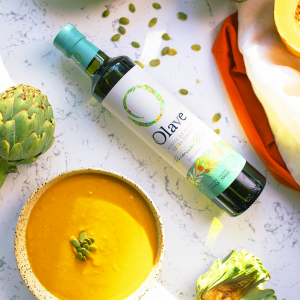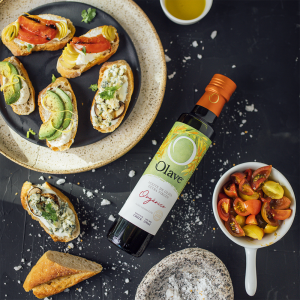Today we explain how to prepare a hummus with extra virgin olive oil. A naturally good and simple recipe!
In Arabic, «hummus» simply means chickpea. It is a meal that brings a touch of the most nutritious and exotic to our diet.
It is a most international dish since it is typical of many countries, from Greece to Arabia, including Cyprus, Turkey, Lebanon, Armenia, Syria, or Israel.
If you look closely, all these countries are also part of the culture of extra virgin olive oil. They have the olive tree as one of their main crops and they use its oil on a recurring basis in their gastronomy.
Like extra virgin olive oil, the popularity of hummus has long since spread throughout the world. It is not surprising since it is also a dish that vegetarians can consume without any problem … and it is very good.
What is traditional hummus and how is it presented?
Hummus is actually nothing more than mashed chickpeas mashed with a fork or in a mortar.
Traditionally, it usually contains a sesame flour paste called tahini, and of course, extra virgin olive oil.
The dish is rounded off with garlic, and lemon juice. We will see that this dish is usually presented adorned with a pinch of paprika on top.
How to make great hummus with extra virgin olive oil
Have you ever wondered how to make a good hummus? The answer is clear and forceful: using a good extra virgin olive oil. Good hummus is smooth, creamy, and silky.
Really, to embroider it, it is a dish where we only need good ingredients, shake off our laziness and use dried chickpeas instead of preserves. This is how it is prepared in the countries of origin of this delicious delicacy.
Step 1: soak chickpeas
This step is easy, but it does require some attention. Think that the chickpeas will more or less double in size so that they absorb the water. So try not to short. The standard proportions would be using about 850ml for 600g of chickpeas.
Step Two: Cook the Chickpeas
Drain and rinse the chickpeas, then place them in a large pot or pressure cooker and cover with water. Also if we wish, we add some garlic cloves, and a little bicarbonate of soda, which always helps to loosen the «skin» of the chickpeas and makes them easier to peel.
Step 3: remove the skin from the chickpeas
In the West we almost always eat chickpeas with the skin, but we will need to remove it if we want to get a really smooth hummus.
We simply “pinch” each chickpea between our fingers once they have cooled. With a good background soundtrack you can easily do it in no time.
Step four: we make a chickpea puree
Add the peeled chickpeas and the cooked garlic in a kitchen utensil that allows you to pass the blender. Normally we have a rotating utensil of the mixer at home … or if you are lucky, you may have a kitchen robot at your fingertips.
While we make this purée, we will have to pour 60-120ml of lemon juice (the amount depends a little on whether you like lemon a lot or not) and salt. This will help to achieve a finer and creamier paste.
The hour of extra virgin olive oil
We add 140 ml of extra virgin olive oil to the pasta, which would be equivalent to a glass or half a cup… With this step we will be able to balance the fatty acids and improve the texture of our hummus.
Peel four cloves of garlic. For many people, two grains of garlic are actually more than enough to prepare half a kilo of chickpeas.
We stop the blender, and finely chop the garlic over our hummus.
At this point, we should now wait 2-3 minutes and let the mixture rest for a bit before continuing to round out the texture with the blender.
We serve the hummus… a few tips
Hummus is usually served cold, with mint leaves as a garnish or with a sprinkle of paprika on top. You can distribute it on one slice per bread (or take it directly by the spoonful!).
If you really want to do it “well”, don’t forget to use the typical Pita bread to dip the recipe.
For those who «hate» garlic, which are many, it may be the substitution of garlic for cumin powder.
For many, especially if you have eaten it since you were little or you are originally from a country where Hummus is made, it should contain Tahina. It’s true! It is a sesame paste that costs a bit to find in the supermarket. It is usually bought in glass jars and is usually sold in specialized stores or halal-style shops. It is also true that, for many, Tahina actually makes the hummus heavier and stickier, more difficult to clean and not as tasty… but we leave that to your discretion.





